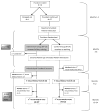A randomized controlled trial of communication training with primary care providers to improve patient-centeredness and health risk communication
- PMID: 20219315
- PMCID: PMC3539754
- DOI: 10.1016/j.pec.2010.01.021
A randomized controlled trial of communication training with primary care providers to improve patient-centeredness and health risk communication
Abstract
Objective: to determine the efficacy and effectiveness of training to improve primary care providers' patient-centered communication skills and proficiency in discussing their patients' health risks.
Methods: twenty-eight primary care providers participated in a baseline simulated patient interaction and were subsequently randomized into intervention and control groups. Intervention providers participated in training focused on patient-centered communication about behavioral risk factors. Immediate efficacy of training was evaluated by comparing the two groups. Over the next 3 years, all providers participated in two more sets of interactions with patients. Longer term effectiveness was assessed using the interaction data collected at 6 and 18 months post-training.
Results: The intervention providers significantly improved in patient-centered communication and communication proficiencies immediately post-training and at both follow-up time points.
Conclusions: this study suggests that the brief training produced significant and large differences in the intervention group providers which persisted 2 years after the training.
Practice implications: the results of this study suggest that primary care providers can be trained to achieve and maintain gains in patient-centered communication, communication skills and discussion of adverse childhood events as root causes of chronic disease.
2010 Elsevier Ireland Ltd. All rights reserved.
Figures

Similar articles
-
Communication training improves patient-centered provider behavior and screening for soldiers' mental health concerns.Patient Educ Couns. 2016 Jul;99(7):1203-1212. doi: 10.1016/j.pec.2016.01.018. Epub 2016 Jan 28. Patient Educ Couns. 2016. PMID: 26884315
-
Improving patient-centered communication: Results of a randomized controlled trial.Patient Educ Couns. 2016 Jan;99(1):117-24. doi: 10.1016/j.pec.2015.08.012. Epub 2015 Aug 14. Patient Educ Couns. 2016. PMID: 26490488 Clinical Trial.
-
Can teaching agenda-setting skills to physicians improve clinical interaction quality? A controlled intervention.BMC Med Educ. 2008 Jan 14;8:3. doi: 10.1186/1472-6920-8-3. BMC Med Educ. 2008. PMID: 18194559 Free PMC article. Clinical Trial.
-
Best Practices in Relational Skills Training for Medical Trainees and Providers: An Essential Element of Addressing Adverse Childhood Experiences and Promoting Resilience.Acad Pediatr. 2017 Sep-Oct;17(7S):S102-S107. doi: 10.1016/j.acap.2017.03.006. Epub 2017 Mar 15. Acad Pediatr. 2017. PMID: 28315415 Review.
-
Simulation: improving communication with patients.Semin Perinatol. 2013 Jun;37(3):157-60. doi: 10.1053/j.semperi.2013.02.006. Semin Perinatol. 2013. PMID: 23721771 Review.
Cited by
-
Empowering Women's Prenatal Communication: Does Literacy Matter?J Health Commun. 2015;20 Suppl 2(0 2):60-8. doi: 10.1080/10810730.2015.1080330. J Health Commun. 2015. PMID: 26513032 Free PMC article. Clinical Trial.
-
Trauma-informed medical care: CME communication training for primary care providers.Fam Med. 2015 Jan;47(1):7-14. Fam Med. 2015. PMID: 25646872 Free PMC article. Clinical Trial.
-
The use of the roter interaction analysis system in assessing veterinary student clinical communication skills during equine wellness examinations in rural Kentucky, USA: A pilot study.Vet Rec Open. 2021 Nov 24;8(1):e23. doi: 10.1002/vro2.23. eCollection 2021 Dec. Vet Rec Open. 2021. PMID: 34853697 Free PMC article.
-
Early Antibiotics and Childhood Obesity: Do Future Risks Matter to Parents and Physicians?Clin Pediatr (Phila). 2019 Feb;58(2):191-198. doi: 10.1177/0009922818809534. Epub 2018 Oct 26. Clin Pediatr (Phila). 2019. PMID: 30362824 Free PMC article.
-
Provider perspectives on the role of the patient as an active participant in HIV care.Glob Public Health. 2021 Oct;16(10):1645-1655. doi: 10.1080/17441692.2020.1830296. Epub 2020 Oct 6. Glob Public Health. 2021. PMID: 33019854 Free PMC article.
References
-
- Smith BW, Zautra AJ. Vulnerability and resilience in women with arthritis: Test of a two factor model. J Consult Clin Psychol. 2008;76:799–810. - PubMed
-
- Coulehan JL, Schulberg HC, Block MR, Madonia MJ, Rodriguez E. Treating depressed primary care patients improves their physical, mental, and social functioning. Arch Intern Med. 1997 May 26;157(10):1113–20. - PubMed
-
- Mechanic D. Sociological dimensions of illness behavior. Soc Sci Med. 1995;41(9):1207–16. - PubMed
-
- Paxton RJ, Valois RF, Watkins KW, Huebner ES, Drane JW. Associations between depressed mood and clusters of health risk behaviors. Am J Health Behav. 2007;31(3):272–283. - PubMed
Publication types
MeSH terms
Grants and funding
LinkOut - more resources
Full Text Sources
Medical

